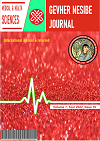Investigation of the Approaches to The Near-Death Experiences in Patients Returning to Life After Cardiac Arrest: A Qualitative Study
DOI:
https://doi.org/10.46648/gnj.280Keywords:
Cardiac arrest, the near death experiences, cardiopulmonary resuscitationAbstract
Objectıves: Patients with cardiac arrest (CA) who undergo cardiopulmonary resuscitation may experience cognitive processes, and some may accurately describe the events experienced during the arrest, indicating the presence of consciousness. The aim of this study was to investigate the approaches to near death experiences in patients who returned to life after cardiac arrest. Materials and Methods: The study was conducted in qualitative type. The sample consisted of 12 patients hospitalized in the cardiology intensive care clinics of a private hospital who were arrested and returned to life with successful resuscitation. Purposeful sampling method was used in sample selection. The reason for these clinics is that one of the researchers is working at this institution and has successfully resuscitated these patients and returned them to life. Data were collected between March and May 2019 by face-to-face interview method. In-depth interview; Key questions determined by literature review and expert opinion and forms containing guiding questions for each key question were used. These forms were Semi-Structured Questionnaire, Individual Information Form and Informing and Consent Form. Two academicians and one specialist physician were interviewed on the draft form based on the literature, meaning disorders and deficiencies were resolved. Interviews were held in the meeting room of the hospital. Each of the interviews lasted approximately 40-50 minutes and was terminated after the interviews were continued by both participants and researchers until there was no more information available. Interview; On the basis of confidentiality, participants were given a code (Code: K.1, E.1) and audio recording was taken. The data obtained from the interviews were transferred from the voice recorder to the computer. Coding-based content analysis was used for data analysis. In this analysis, similar data were classified under certain concepts and themes and interpreted in a comprehensible manner. Frequency and percentages of individual information were calculated and expressed. The data obtained were reported in detail and the validity of the study was ensured by direct quotations. Results: According to the findings of the study, 75% of the participants were male, the average age was 63, 50% were university graduates, as religious tendency, 41.7% Deist and 50% as religious. 75% of the respondents evaluated this as a death experience. When the answers given by the participants to the interview questions were examined in general, it was determined that there was “a feeling of relaxation and serenity”, “time passed rapidly, light emitted from a deep darkness”, “pain and pain were not felt”, and the happiness of returning to life for a second time was very valuable. Conclusion: In this study where the experience of approaching the threshold of dying was examined in those who returned to life after cardiac arrest, most of the participants stated that they accepted this process as a “death experience.. In addition, the forms and expressions of the interviewed patients describing the events they experienced during the cardiac arrest process indicate the presence of consciousness; The feeling of peace, from a deep darkness to light with expressions were identified. In addition to repeating the study with a larger sample, it is recommended that health professionals involved in the arrest process be informed about this issue.
Downloads
Published
How to Cite
Issue
Section
License

This work is licensed under a Creative Commons Attribution-NonCommercial 4.0 International License.


